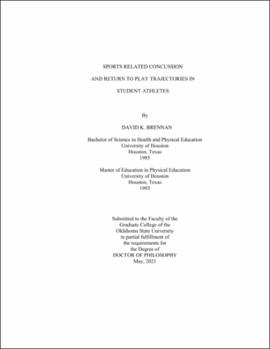| dc.contributor.advisor | Dawes, Jay | |
| dc.contributor.author | Brennan, David K. | |
| dc.date.accessioned | 2021-09-24T13:33:11Z | |
| dc.date.available | 2021-09-24T13:33:11Z | |
| dc.date.issued | 2021-05 | |
| dc.identifier.uri | https://hdl.handle.net/11244/330897 | |
| dc.description.abstract | The United States CDC reported between 1.6 and 3.8 million participants in sports and recreational activities sustain a concussion annually. Sports related concussion (SRC) management requires a blend clinical judgement and an analysis of symptomatology, cognition, and physical performance. This retrospective study examines the relationship between return to play trajectory (RTPt) and three common clinical measures, symptoms, balance, and reaction time. | |
| dc.description.abstract | Methods: Student athletes (30 males, 39 females), age, M = 14.2, SD = 2.2 years, medical records were reviewed. Pre-treatment concussion symptom scale (PCSS), balance (mBESS) and simple reaction time (RT) measures were compared to RTPt. Pearson's coefficients were calculated for independent variables PCSS, mBESS, RT against RTPt. Male and female differences were assessed through independent t-tests. The alpha was set at p < .05. Hedge's g calculated the effect size. | |
| dc.description.abstract | Findings: There was a moderate positive association between PCSS and RTPt, (r = .323, p = .003), a moderate positive association between time till treatment (TTT) and RTPt ( r = .471, p < .000) a small negative correlation between mBESS and RTPt (r = -.147, p = .114) and a weak negative association between RT and RTPt (r = -.023, p = .426). Sex differences for RTPt, mBESS and RT were not statistically significant. Females on average took almost two weeks longer to recover than males, M =13.6, SD +/-10.6, days longer (p = .202). A loss of conscious (LOC), accounted for 17.3% of athletes and this group had a longer RTPt, (M = 14.5, SE +/- 13.9 days) than negative for LOC. These differences were not significant. Sixty-six percent of athletes were positive for visual ocular-motor screen with differences in RTPt for athletes positive for VOMS were not statistically different to athletes who were negative (p = .300). Regression model for PCSS on RTPt revealed an adjusted R2 of 9.1% (p = .009) and for TTT and PCSS on RTPt an R2 of 42.7%, and an adjusted R2 of 41% (p < 001). | |
| dc.description.abstract | Conclusions: TTT and PCSS have a moderate association with RTPt in a population of sub-acute and chronic SRCs. PCSS as a predictor of RTPt indicated a .655-day increase in RTPt for every 1-point increase in PCSS. There was 1.01-day increase in RTPt for every 1-day increase in TTT. | |
| dc.format | application/pdf | |
| dc.language | en_US | |
| dc.rights | Copyright is held by the author who has granted the Oklahoma State University Library the non-exclusive right to share this material in its institutional repository. Contact Digital Library Services at lib-dls@okstate.edu or 405-744-9161 for the permission policy on the use, reproduction or distribution of this material. | |
| dc.title | Sports related concussion and return to play trajectories in student athletes | |
| dc.contributor.committeeMember | Lindenmeier, Donna K. | |
| dc.contributor.committeeMember | Khojasteh, Jam Justin | |
| dc.contributor.committeeMember | Volberding, Jennifer L. | |
| osu.filename | Brennan_okstate_0664D_17199.pdf | |
| osu.accesstype | Open Access | |
| dc.type.genre | Dissertation | |
| dc.type.material | Text | |
| dc.subject.keywords | balance | |
| dc.subject.keywords | reaction time | |
| dc.subject.keywords | return to play trajectory | |
| dc.subject.keywords | sports related concussion | |
| dc.subject.keywords | student athletes | |
| dc.subject.keywords | symptomatology | |
| thesis.degree.discipline | Health, Leisure and Human Performance | |
| thesis.degree.grantor | Oklahoma State University | |
